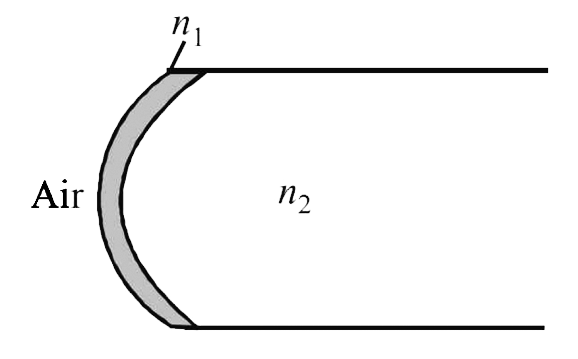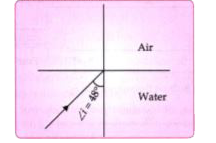A ray of light travelling obliquely from glass to air :
bends towards the normal
bends away from the normal
does not deviate from its path
none of these
To solve the question about a ray of light travelling obliquely from glass to air, we can follow these steps:
1. Identify the Media:
- The ray of light is moving from glass (denser medium) to air (rarer medium).
2. Understand Refraction:
- Refraction occurs when light passes from one medium to another, causing it to change direction.
3. Determine the Direction of Bending:
- When light travels from a denser medium (glass) to a rarer medium (air), it bends away from the normal line. The normal line is an imaginary line perpendicular to the surface at the point of incidence.
4. Apply Snell's Law:
- Although we don't need to calculate angles here, it's useful to remember that Snell's Law states:
n1sin(θ1)=n2sin(θ2)
where n1 and n2 are the refractive indices of the two media, and θ1 and θ2 are the angles of incidence and refraction, respectively.
5. Conclusion:
- Since the light is moving from a denser medium (glass) to a rarer medium (air), it will bend away from the normal. Therefore, the correct answer is that the ray of light bends away from the normal.
Final Answer:
The ray of light bends away from the normal when travelling from glass to air.
---
- The ray of light is moving from glass (denser medium) to air (rarer medium).
- Refraction occurs when light passes from one medium to another, causing it to change direction.
- When light travels from a denser medium (glass) to a rarer medium (air), it bends away from the normal line. The normal line is an imaginary line perpendicular to the surface at the point of incidence.
- Although we don't need to calculate angles here, it's useful to remember that Snell's Law states:
n1sin(θ1)=n2sin(θ2)
where n1 and n2 are the refractive indices of the two media, and θ1 and θ2 are the angles of incidence and refraction, respectively.
- Since the light is moving from a denser medium (glass) to a rarer medium (air), it will bend away from the normal. Therefore, the correct answer is that the ray of light bends away from the normal.
The ray of light bends away from the normal when travelling from glass to air.
Topper's Solved these Questions
- LIGHT ENERGYBOOK - ICSECHAPTER - LIGHT ENERGYEXERCISE - EXERCISE-5.3 (Objective Type Questions) E. Match the statements in column A, with those in Column B.
1 Videos
- LIGHT ENERGYBOOK - ICSECHAPTER - LIGHT ENERGYEXERCISE - EXERCISE-5.3 (STUDY QUESTIONS)
6 Videos
- LIGHT ENERGYBOOK - ICSECHAPTER - LIGHT ENERGYEXERCISE - EXERCISE-5.3 (Objective Type Questions) C. Write .true.of .false. for the following statements :
5 Videos
- HEAT TRANSFER BOOK - ICSECHAPTER - HEAT TRANSFER EXERCISE - Picture Study
2 Videos
- MATTER BOOK - ICSECHAPTER - MATTER EXERCISE - THEME ASSIGNMENT
25 Videos
Similar Questions
When a ray of light travels obliquely from a rarer medium to a denser medium, it bends away from the normal.
View Solution(a) State Snell's law of refraction of light.
(b) A transparent medium A floats on another transparent medium B. When a ray of light travels obliquely from A into B, the refracted ray bends away from from the normal. Which of these two media A or B are optically denser and why ?
View SolutionA transparent thin film of uniform thickness and refractive index n1=1.4 is coated on the convex spherical surface of radius R at one end of a long solid glass cylinder of refractive index n2=1.5, as shown in the figure. Rays of light parallel to the axis of the cylinder traversing through the film from air to glass get focused at distance f1 from the film, while rays of light traversing from glass to air get focused at distance f2 from the film, Then

View SolutionA ray of light travelling in air enters obliquely into water. Does the light ray bend towards the normal or away from the normal ? Why ?
View SolutionA ray of light travelling in glass having refractive index _(a)μg=3/2 is incident at a critical angle C on the glass air interface. If a thin layer of water is poured on glass air interface, then what will be the angle of emergence of this ray in air when it emerges from water air inteface?
View SolutionA ray of light travelling in air strikes the surface of glass at angle of 450. The angle of refraction in the glass will be :
View SolutionA ray of light travelling in glass (μg=3/2) is incident on a horizontal glass-air surface at the critical angle θC. If a thin layer of water (μw=4/3) is now poured on the glass-air surface. At what angle will the ray of light emerges into water at glass-water surface?
View SolutionA ray of light travelling in glass (μ=3/2) is incident on a horizontal glass air surface at the critical angle θC. If a thin layer of water (μ=4/3) is now poured on the glass air surface, the ray of light emerge into air at the water air surface at an angle of π/k, radians find the value of k.
View SolutionA ray of light travelling in water is incident on its surface open to air. The angle of incidence is θ, which is less than the critical angle. Then there will be
View SolutionA ray of light travels from water to air as shown in the diagram given below:

Copy the diagram and complete the path of the ray. Given the critical angle for water is 48∘.
View Solution
